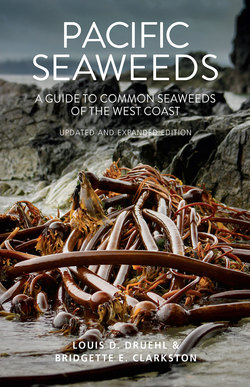Читать книгу Pacific Seaweeds - Louis Druehl - Страница 15
На сайте Литреса книга снята с продажи.
Оглавление15
About Seaweeds
the sea lettuce; if you were to draw a circle on the Ulva blade (can be done with India ink) and follow the change in the circle as the plant grew, you would see the circle expand but retain its original proportions. In the second way seaweeds grow, called intercalary growth, cells divide only in certain locations, not all over the whole body and not at the base or tip of the seaweed. In kelp, for example, cell division occurs between the stipe and blade. If you drew a grid across the upper portion of the stipe and base of the blade, the grid would expand unevenly over time. The grid points nearest the blade base would be farther apart than the points more distant from the blade base, because most of the active cell division takes place within a few centimetres of the base. In the third mode of growth, termed apical growth, most of the growth is associated with one (e.g., Fucus, p. 181) or many (most red algae) actively dividing apical cells located at the outer extremes of the seaweed. A grid marked on a seaweed with apical growth would expand along the margins of the seaweed and remain relatively unchanged near the seaweed centre.
Seaweeds take on a bewildering range of forms. In their extreme, they range from a single-celled green sphere about 1 cm (0.4 in) in diameter (Derbesia, p. 57) to what appears to be a large (up to 36 m/118 ft long) brown onion (Nereocystis, p. 226). Seaweeds may be filamentous, branched or not. They may be fleshy crusts, blades, tubes or bushes, flattened or radially branched. All of these forms are found in the red, green and brown seaweed groups. This repetition of form has led many researchers, like Diane and Mark Littler (Smithsonian Institution), Patrick Martone (University of British Columbia) and various colleagues, to consider the functional role of form. Does a particular form convey a competitive advantage? Are some forms better able to withstand high-energy waves? Do different forms dominate during different stages of succession (the development of
Figure 3. Common seaweed branching patterns.
